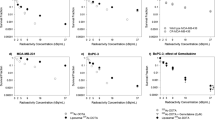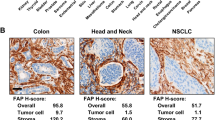Abstract
Purpose
In this study, a novel aluminium-[18F]fluoride (Al18F)-labelled 1,4,7‑triazacyclononane-N,N′,N″-triacetic acid (NOTA)-conjugated fibroblast activation protein inhibitor (FAPI) probe, named Al18F-NOTA-FAPI, was developed for fibroblast activation protein (FAP)-targeted tumour imaging; it could deliver hundreds of millicuries of radioactivity using automated synthesis. The tumour detection efficacy of Al18F-NOTA-FAPI was further validated in both preclinical and clinical translational studies.
Methods
The radiolabelling procedure of Al18F-NOTA-FAPI was optimized. Cell uptake and competitive binding assays were completed with the U87MG and A549 cell lines to evaluate the affinity and specificity of the Al18F-NOTA-FAPI probe. The biodistribution, pharmacokinetics, radiation dosimetry and tumour imaging efficacy of the Al18F-NOTA-FAPI probe were researched in healthy Kunming (KM) and/or U87MG model mice. After the approval of the ethical committee, the Al18F-NOTA-FAPI probe was translated into the clinic for PET/CT imaging of the first 10 cancer patients.
Results
The radiolabelling yield of Al18F-NOTA-FAPI was 33.8 ± 3.2% using manual synthesis (n = 10), with a radiochemical purity over 99% and the specific activity of 9.3–55.5 MBq/nmol. The whole body effective dose of Al18F-NOTA-FAPI was estimated to be 1.24E − 02 mSv/MBq, which was lower than several other FAPI probes (68Ga-FAPI-04, 68Ga-FAPI-46 and 68Ga-FAPI-74). In U87MG tumour-bearing mice, Al18F-NOTA-FAPI showed good tumour detection efficacy based on the results of micro PET/CT imaging and biodistribution studies. In an organ biodistribution study of patients, Al18F-NOTA-FAPI showed a lower SUVmean than 2-[18F]-fluoro-2-deoxy-D-glucose (2-[18F]FDG) in most organs, especially in the liver (1.1 ± 0.2 vs. 2.0 ± 0.9), brain (0.1 ± 0.0 vs. 5.9 ± 1.3), and bone marrow (0.9 ± 0.1 vs. 1.7 ± 0.4). Meanwhile, Al18F-NOTA-FAPI did not show extensive bone uptake, and was able to detect more lesions than 2-[18F]FDG in the PET/CT imaging of several patients.
Conclusion
The Al18F-NOTA-FAPI probe was successfully fabricated and applied in fibroblast activation protein-targeted tumour PET/CT imaging, which showed excellent imaging quality and tumour detection efficacy in U87MG tumour-bearing mice as well as in cancer patients.
Trial registration
Chinese Clinical Trial Registry ChiCTR2000038080. Registered 09 September 2020. http://www.chictr.org.cn/showproj.aspx?proj=61192








Similar content being viewed by others
Data availability
Not applicable.
Code availability
Not applicable.
References
Liu R, Li H, Liu L, Yu J, Ren X. Fibroblast activation protein: a potential therapeutic target in cancer. Cancer Biol Ther. 2012;13:123–9.
Kalluri R. The biology and function of fibroblasts in cancer. Nat Rev Cancer. 2016;16:582–98.
Sánchez-Garrido MA, Habegger KM, Clemmensen C, Holleman C, Müller TD, Perez-Tilve D, et al. Fibroblast activation protein (FAP) as a novel metabolic target. Mol Metab. 2016;5:1015–24.
Teichgräber V, Monasterio C, Chaitanya K, Boger R, Gordon K, Dieterle T, et al. Specific inhibition of fibroblast activation protein (FAP)-alpha prevents tumor progression in vitro. Adv Med Sci. 2015;60:264–72.
Chen M, Lei X, Shi C, Huang M, Li X, Wu B, et al. Pericyte-targeting prodrug overcomes tumor resistance to vascular disrupting agents. J Clin Invest. 2017;127:2689–701.
Wang J, Li Q, Li X, Yuan W, Huang S, Cai S, et al. A novel FAPα-based Z-Gly-Pro epirubicin prodrug for improving tumor-targeting chemotherapy. Eur J Pharmacol. 2017;815:166–72.
Scott AM, Wiseman G, Welt S, Adjei A, Lee FT, Hopkins W, et al. A phase I dose-escalation study of sibrotuzumab in patients with advanced or metastatic fibroblast activation protein-positive cancer. Clin Cancer Res. 2003;9:1639–47.
Wang LS, Lo A, Scholler J, Sun J, Majumdar RS, Kapoor V, et al. Targeting fibroblast activation protein in tumor stroma with chimeric antigen receptor T cells can inhibit tumor growth and augment host immunity without severe toxicity. Cancer Immunol Res. 2014;2:154–66.
Loeffler M, Krüger JA, Niethammer AG, Reisfeld RA. Targeting tumor-associated fibroblasts improves cancer chemotherapy by increasing intratumoral drug uptake. J Clin Invest. 2006;116:1955–62.
Lee J, Fassnacht M, Nair S, Boczkowski D, Gilboa E. Tumor immunotherapy targeting fibroblast activation protein, a product expressed in tumor-associated fibroblasts. Cancer Res. 2005;65:11156–63.
Jansen K, Heirbaut L, Verkerk R, Cheng JD, Joossens J, Cos P, et al. Extended structure-activity relationship and pharmacokinetic investigation of (4-quinolinoyl)glycyl-2-cyanopyrrolidine inhibitors of fibroblast activation protein (FAP). J Med Chem. 2014;57:3053–74.
Lindner T, Loktev A, Altmann A, Giesel F, Kratochwil C, Debus J, et al. Development of quinoline-based theranostic ligands for the targeting of fibroblast activation protein. J Nucl Med. 2018;59:1415–22.
Kratochwil C, Flechsig P, Lindner T, Abderrahim L, Altmann A, Mier W, et al. 68Ga-FAPI PET/CT: tracer uptake in 28 different kinds of cancer. J Nucl Med. 2019;60:801–5.
Lindner T, Altmann A, Krämer S, Kleist C, Loktev A, Kratochwil C, Giesel F, Mier W, Marme F, Debus J, Haberkorn U. Design and development of 99mTc-labeled FAPI tracers for SPECT imaging and 188Re therapy. J Nucl Med. 2020;61:1507–13.
Watabe T, Liu Y, Kaneda-Nakashima K, Shirakami Y, Lindner T, Ooe K, et al. Theranostics targeting fibroblast activation protein in the tumor stroma: 64Cu- and 225Ac-labeled FAPI-04 in pancreatic cancer xenograft mouse models. J Nucl Med. 2020;61:563–9.
Giesel FL, Kratochwil C, Lindner T, Marschalek MM, Loktev A, Lehnert W, et al. 68Ga-FAPI PET/CT: biodistribution and preliminary dosimetry estimate of 2 DOTA-containing FAP-targeting agents in patients with various cancers. J Nucl Med. 2019;60:386–92.
Sabri S, Patrick C, Felix MM. The battle on time, money and precision: Da[18F] id vs. [68Ga]liath. Eur J Nucl Med Mol Imaing. 2020;47:2944–6.
Giesel FL, Adeberg S, Syed M, Lindner T, Jimenez LD, Mavriopoulou E, et al. FAPI-74 PET/CT using either 18F-AlF or cold-kit 68Ga-labeling: biodistribution, radiation dosimetry and tumor delineation in lung cancer patients. J Nucl Med. 2021;62:201–7.
Toms J, Kogler J, Maschauer S, Daniel C, Schmidkonz C, Kuwert T, et al. Targeting fibroblast activation protein: radiosynthesis and preclinical evaluation of an 18F-labeled FAP inhibitor. J Nucl Med. 2020;61:1806–13.
Liu T, Liu C, Xu X, Liu F, Guo X, Li N, et al. Preclinical evaluation and pilot clinical study of Al18F-PSMA-BCH for prostate cancer PET imaging. J Nucl Med. 2019;60:1284–92.
Mentlein R, Hattermann K, Hemion C, Jungbluth AA, Held-Feindt J. Expression and role of the cell surface protease seprase/fibroblast activation protein-α (FAP-α) in astroglial tumors. Biol Chem. 2011;392:199–207.
Loktev A, Lindner T, Burger EM, Altmann A, Giesel F, Kratochwil C, et al. Development of fibroblast activation protein-targeted radiotracers with improved tumor retention. J Nucl Med. 2019;60:1421–9.
Chen H, Pang Y, Wu J, Zhao L, Hao B, Wu J, et al. Comparison of [68Ga]Ga-DOTA-FAPI-04 and [18F] FDG PET/CT for the diagnosis of primary and metastatic lesions in patients with various types of cancer. Eur J Nucl Med Mol Imaging. 2020;47:1820–32.
Xie Q, Liu T, Ding J, Zhou N, Meng X, Zhu H, et al. Synthesis, preclinical evaluation, and a pilot clinical imaging study of [18F]AlF-NOTA-JR11 for neuroendocrine neoplasms compared with [68Ga]Ga-DOTA-TATE. Eur J Nucl Med Mol Imaging. 2021. https://doi.org/10.1007/s00259-021-05249-8.
Acknowledgements
We gratefully appreciate all of the chemists, nurses and technicians from the Department of Nuclear Medicine, Peking University Cancer Hospital, for their contributions to tracer administration and PET/CT imaging.
Funding
This work was supported by the National Natural Science Foundation of China projects No. 81871386 and 81871387, Yangfan project No. ZYLX201816, Dengfeng project No. DFL20191102, and Science Foundation of Peking University Cancer Hospital-2020–18.
Author information
Authors and Affiliations
Contributions
ZY and HZ conceived and designed this research. SW was responsible for all of the experiments, data collection and analysis, and wrote the manuscript. XZ and XX were responsible for the recruitment of patients and image analysis. JD, SL and XH were involved in the preparation of radiopharmaceuticals and took part in most of the animal experiments. All of the authors participated in the revision of the article.
Corresponding authors
Ethics declarations
Ethics approval
All procedures involving human participants were carried out in accordance with the Ethics Committee of Peking University Cancer Hospital (2019 KT95), and registered in Chinese Clinical Trial Registry (ChiCTR2000038080). All animal studies were performed according to a protocol approved by the Peking University Cancer Hospital Animal Care and Use Committee.
Consent to participate
Written informed consent was obtained from all participants included in the study.
Consent for publication
Not applicable.
Conflict of interest
The authors declare no competing interests.
Additional information
Publisher’s note
Springer Nature remains neutral with regard to jurisdictional claims in published maps and institutional affiliations.
This article is part of the Topical Collection on Translational research
Supplementary Information
Below is the link to the electronic supplementary material.
Rights and permissions
About this article
Cite this article
Wang, S., Zhou, X., Xu, X. et al. Clinical translational evaluation of Al18F-NOTA-FAPI for fibroblast activation protein-targeted tumour imaging. Eur J Nucl Med Mol Imaging 48, 4259–4271 (2021). https://doi.org/10.1007/s00259-021-05470-5
Received:
Accepted:
Published:
Issue Date:
DOI: https://doi.org/10.1007/s00259-021-05470-5




